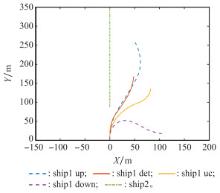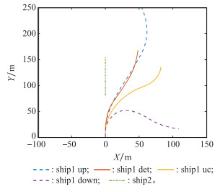Systems Engineering and Electronics ›› 2025, Vol. 47 ›› Issue (2): 621-632.doi: 10.12305/j.issn.1001-506X.2025.02.28
• Guidance, Navigation and Control • Previous Articles
Robust trajectory planning for ship collision avoidance based on polynomial chaotic expansion
Xinyu QI, Zhi ZHANG, Xiaobing SHANG, Yiqiong ZHANG, Lichao JIANG, Yuexin ZHOU
- School of Intelligent Science and Engineering, Harbin Engineering University, Harbin 150001, China
-
Received:2024-02-20Online:2025-02-25Published:2025-03-18 -
Contact:Zhi ZHANG
CLC Number:
Cite this article
Xinyu QI, Zhi ZHANG, Xiaobing SHANG, Yiqiong ZHANG, Lichao JIANG, Yuexin ZHOU. Robust trajectory planning for ship collision avoidance based on polynomial chaotic expansion[J]. Systems Engineering and Electronics, 2025, 47(2): 621-632.
share this article
Table 2
Ship encounter situations"
| 会遇态势 | 船舶 | 初始横坐标/m | 初始纵坐标/m | 初始速度/(m/s) | 初始艏向/rad |
| 对遇 | 本船 | 0 | 0 | 7 | 2π |
| 来船 | 0 | 350 | 7 | $-\frac{1}{2} \mathsf{π} $ | |
| 小角度右舷交叉 | 本船 | 0 | 0 | 7 | $\frac{1}{2}\mathsf{π} $ |
| 来船 | 50 | 210 | 7 | $-\frac{2}{3}\mathsf{π} $ | |
| 大角度右舷交叉 | 本船 | 0 | 0 | 7 | $\frac{1}{2}\mathsf{π} $ |
| 来船 | 160 | 80 | 7 | π | |
| 追越 | 本船 | 0 | 0 | 7 | $\frac{1}{2}\mathsf{π} $ |
| 来船 | 0 | 80 | 7 | $\frac{1}{2}\mathsf{π} $ |
| 1 | LI X P , ZHAO X Y , BAI D L . Marine transport efficiency evaluation of cross-border logistics based on AHP-TOPSIS method[J]. Journal of Coastal Research, 2020, 110 (SI): 95- 99. |
| 2 |
LIU R Z , WANG T , LI J D , et al. Simulation of seasonal transport of microplastics and influencing factors in the China Seas based on the ROMS model[J]. Water Research, 2023, 244, 120493.
doi: 10.1016/j.watres.2023.120493 |
| 3 |
HUANG Y , COLIN C , LIU Z F , et al. Impacts of nepheloid layers and mineralogical compositions of oceanic margin sediments on REE concentrations and Nd isotopic compositions of seawater[J]. Geochimica et Cosmochimica Acta, 2023, 359, 57- 70.
doi: 10.1016/j.gca.2023.08.026 |
| 4 |
LIANG X Y , WANG L Z , DU W , et al. Emission factors of oxygenated polycyclic aromatic hydrocarbons from ships in China[J]. Environmental Pollution, 2023, 337, 122483.
doi: 10.1016/j.envpol.2023.122483 |
| 5 | LI L L, WANG J K. SAR image ship detection based on ant co-lony optimization[C]//Proc. of the 5th International Congress on Image and Signal Processing, 2012: 1100-1103. |
| 6 |
夏悠然, 管军, 易文俊. 基于改进粒子群优化极限学习机的弹丸参数辨识[J]. 系统工程与电子技术, 2023, 45 (2): 521- 529.
doi: 10.12305/j.issn.1001-506X.2023.02.24 |
|
XIA Y R , GUAN J , YI W J . Projectile parameter identification: extreme learning machine optimized by improved particle swarm[J]. Systems Engineering and Electronics, 2023, 45 (2): 521- 529.
doi: 10.12305/j.issn.1001-506X.2023.02.24 |
|
| 7 | CHEN Y Q, LI T X. Collision avoidance of unmanned ships based on artificial potential field[C]//Proc. of the Chinese Automation Congress, 2017: 4437-4440. |
| 8 | REN L , ZHANG W X . Matching optimization of ship engine and propeller based on PSO-GA algorithm[J]. Applied Mechanics and Materials, 2012, 121, 4503- 4507. |
| 9 | CHEN X J, LIU Y X, HONG X B, et al. Unmanned ship path planning based on RRT[C]//Proc. of the International Conference on Intelligent Computing, 2018. |
| 10 | 杨荣武, 许劲松, 王鑫. 船舶自主避碰的慎思型轨迹规划[J]. 上海交通大学学报, 2019, 53 (12): 1411- 1419. |
| YANG R W , XU J S , WANG X . Deliberative trajectory planning for autonomous collision avoidance of ships[J]. Journal of Shanghai Jiao Tong University, 2019, 53 (12): 1411- 1419. | |
| 11 | 徐杨, 陆丽萍, 褚端峰, 等. 无人车辆轨迹规划与跟踪控制的统一建模方法[J]. 自动化学报, 2019, 45 (4): 799- 807. |
| XU Y , LU L P , CHU D F , et al. An unified modeling method for trajectory planning and tracking control of unmanned vehicles[J]. Journal of Automation, 2019, 45 (4): 799- 807. | |
| 12 | 姚绪梁, 王峰, 王景芳, 等. 不确定海流环境下水下机器人最优时间路径规划[J]. 控制理论与应用, 2020, 37 (6): 1302- 1310. |
| YAO X L , WANG F , WANG J F , et al. Optimal time path planning for underwater robots in uncertain ocean current environments[J]. Control Theory & Applications, 2020, 37 (6): 1302- 1310. | |
| 13 |
汪萌, 诸兵. 不确定性建模在2D和3D目标检测中的应用[J]. 系统工程与电子技术, 2023, 45 (8): 2370- 2376.
doi: 10.12305/j.issn.1001-506X.2023.08.10 |
|
WANG M , CHU B . Application of uncertainty modeling in 2D and 3D object detection[J]. Systems Engineering and Electro-nics, 2023, 45 (8): 2370- 2376.
doi: 10.12305/j.issn.1001-506X.2023.08.10 |
|
| 14 |
CHAUDHURI A , WAYCASTER G , PRICE N , et al. NASA uncertainty quantification challenge: an optimization-based methodology and validation[J]. Journal of Aerospace Information Systems, 2015, 12 (1): 10- 34.
doi: 10.2514/1.I010269 |
| 15 |
GHANEM R , YADEGARAN I , THIMMISETTY C , et al. Pro-babilistic approach to NASA Langley research center multidisciplinary uncertainty quantification challenge problem[J]. Journal of Aerospace Information Systems, 2015, 12 (1): 170- 188.
doi: 10.2514/1.I010271 |
| 16 |
BAI Y L , HUANG Z Y , LAM H . Model calibration via distributionally robust optimization: on the NASA Langley uncertainty quantification challenge[J]. Mechanical Systems and Signal Processing, 2022, 164, 108211.
doi: 10.1016/j.ymssp.2021.108211 |
| 17 |
SEPKA S A , WRIGHT M . Monte Carlo approach to FIAT uncertainties with applications for Mars science laboratory[J]. Journal of Thermophysics and Heat Transfer, 2011, 25 (4): 516- 522.
doi: 10.2514/1.49804 |
| 18 | HALDER A . Probabilistic methods for model validation[M]. College Station, Texas: Texas A&M University, 2014. |
| 19 | FEISCHL M , SCAGLIONI A . Convergence of adaptive stochastic collocation with finite elements[J]. Computers & Mathematics with Applications, 2021, 98, 139- 156. |
| 20 |
ZENG P , LI T B , CHEN Y , et al. New collocation method for stochastic response surface reliability analyses[J]. Engineering with Computers, 2020, 36, 1751- 1762.
doi: 10.1007/s00366-019-00793-2 |
| 21 |
JIA B , XIN M . Short-arc orbital uncertainty propagation with arbitrary polynomial chaos and admissible region[J]. Journal of Guidance, Control, and Dynamics, 2020, 43 (4): 715- 728.
doi: 10.2514/1.G004548 |
| 22 | WANG M J, HUANG Q B, LI S D. A subinterval response surface method for frequency response analysis of structural-acoustic system with uncertain-but-bounded parameters[C]//Proc. of the 4th International Conference on Industrial Engineering and Applications, 2017: 327-330. |
| 23 |
LUO Y Z , YANG Z . A review of uncertainty propagation in orbital mechanics[J]. Progress in Aerospace Sciences, 2017, 89, 23- 39.
doi: 10.1016/j.paerosci.2016.12.002 |
| 24 |
YIN S W , YU D J , LUO Z , et al. An arbitrary polynomial chaos expansion approach for response analysis of acoustic systems with epistemic uncertainty[J]. Computer Methods in Applied Mechanics and Engineering, 2018, 332, 280- 302.
doi: 10.1016/j.cma.2017.12.025 |
| 25 |
VITTALDEV V , RUSSELL R P , LINARES R . Spacecraft uncertainty propagation using Gaussian mixture models and polynomial chaos expansions[J]. Journal of Guidance, Control, and Dynamics, 2016, 39 (12): 2615- 2626.
doi: 10.2514/1.G001571 |
| 26 |
HOSDER S , WALTERS R W , BALCH M . Point-collocation nonintrusive polynomial chaos method for stochastic computational fluid dynamics[J]. AIAA Journal, 2010, 48 (12): 2721- 2730.
doi: 10.2514/1.39389 |
| 27 | 谢朔. 基于天牛须优化的船舶运动建模与避碰方法研究[D]. 武汉: 武汉理工大学, 2022. |
| XIE S. Research on ship motion modeling and collision avoidance methods based on optimization of longhorn whiskers[D]. Wuhan: Wuhan University of Technology, 2022. | |
| 28 |
郑中义, 吴兆麟. 船舶碰撞危险度的新模型[J]. 大连海事大学学报, 2002, 28 (2): 1- 5.
doi: 10.3969/j.issn.1006-7736.2002.02.001 |
|
ZHENG Z Y , WU Z L . A new model of ship collision risk[J]. Dalian Maritime University Journal, 2002, 28 (2): 1- 5.
doi: 10.3969/j.issn.1006-7736.2002.02.001 |
|
| 29 | VARELA J M , GUEDES SOARES C . Geometry and visual realism of ship models for digital ship bridge simulators[J]. Journal of Engineering for the Maritime Environment, 2017, 231 (1): 329- 341. |
| 30 | CHEN L Y , HUANG Y M , ZHENG H R , et al. Cooperative multi-vessel systems in urban waterway networks[J]. IEEE Trans.on Intelligent Transportation Systems, 2019, 21 (8): 3294- 3307. |
| 31 |
GAO H , ZOU Z J , XIA L , et al. Application of the NIPC-based uncertainty quantification in prediction of ship maneuverability[J]. Journal of Marine Science and Technology, 2021, 26, 555- 572.
doi: 10.1007/s00773-020-00754-1 |
| 32 |
KIM H J , KIM Y T , YOON D K . Dependence of polynomial chaos on random types of forces of KdV equations[J]. Applied Mathematical Modelling, 2012, 36 (7): 3080- 3093.
doi: 10.1016/j.apm.2011.09.086 |
| [1] | Haonan WU, Wei HAN, Zishuang PAN, Fang GUO, Xichao SU. Multi-layer coding genetic algorithm-based approach to force action planning for carrier aircraft fleets [J]. Systems Engineering and Electronics, 2025, 47(2): 555-567. |
| [2] | Peiqi WANG, Rusheng JU, Miao ZHANG, Wei DUAN. Data collection strategy of HLA simulation system based on non-dominated genetic algorithm [J]. Systems Engineering and Electronics, 2024, 46(9): 3103-3111. |
| [3] | Xin XI, Gaogao LIU, Qiang LIU, Dongjie HUANG. Distributed jamming optimal array method for sidelobe cancellation [J]. Systems Engineering and Electronics, 2024, 46(8): 2623-2628. |
| [4] | Qiangqiang XU, Hua CHAI. Optimization of task dispatch plan for vehicular optical observation equipment based on NSGA-Ⅱ [J]. Systems Engineering and Electronics, 2024, 46(7): 2393-2400. |
| [5] | Yangyang LI, Junren LUO, Wanpeng ZHANG, Fengtao XIANG. Genetic-evolutionary bi-level mission planning algorithm for multi-satellite cooperative observation [J]. Systems Engineering and Electronics, 2024, 46(6): 2044-2053. |
| [6] | Yiming CAI, Li MA, Hengyang LU, Wie FANG. Full process parallel genetic algorithm for Bayesian network structure learning [J]. Systems Engineering and Electronics, 2024, 46(5): 1703-1711. |
| [7] | Zekun YAO, Chao WANG, Qingzhan SHI, Shaoqing ZHANG, Naichang YUAN. Cooperative jamming resource allocation model for radar network based on improved discrete simulated annealing genetic algorithm [J]. Systems Engineering and Electronics, 2024, 46(3): 824-830. |
| [8] | Shuai YIN, Jianhui YU, Bin SONG, Yanning GUO, Chuanjiang LI, Yueyong LYU. GEO target servicing mission scheduling based on multi-group chaotic genetic algorithm [J]. Systems Engineering and Electronics, 2024, 46(3): 914-921. |
| [9] | Guixiang ZHAO, Chenxu WANG, Jian ZHOU, Yunmiao LI. Collision risk calculation of unmanned surface vehicle based on improved fuzzy evaluation method [J]. Systems Engineering and Electronics, 2024, 46(3): 1031-1037. |
| [10] | Yuting ZHANG, Jingyu YANG. Capability-based defense resource allocation method [J]. Systems Engineering and Electronics, 2024, 46(2): 599-604. |
| [11] | Kai QIN, Shushi GU, Zhikai ZHANG, Yu WANG, Qian LIU, Chen ZHAO, Qinyu ZHANG. Communication tower deployment scheme for lunar surface multi-device communication networks [J]. Systems Engineering and Electronics, 2024, 46(2): 729-739. |
| [12] | Changwei MA, Yaping WANG, Yu ZHANG, Cancan HU. Capability planning method for equipment system of systems based on dynamic replenishment of resources [J]. Systems Engineering and Electronics, 2024, 46(12): 4108-4115. |
| [13] | Yue RAO, Jian YANG, Guomin SUN, Wei ZHANG, Huaizong SHAO, Jingran LIN. Multi-beam satellite dynamic resource allocation method based on improved SA-NSGAⅡ [J]. Systems Engineering and Electronics, 2024, 46(12): 4222-4230. |
| [14] | Enhui WU, Jing LIU, Xu YANG. Minimum orbital intersection distance based space index [J]. Systems Engineering and Electronics, 2024, 46(11): 3784-3791. |
| [15] | Zhiqiang CAO, Jia ZHANG, Bin XIN. UAV search coverage planning under intermittent information transmission condition [J]. Systems Engineering and Electronics, 2024, 46(1): 152-161. |
| Viewed | ||||||
|
Full text |
|
|||||
|
Abstract |
|
|||||



















